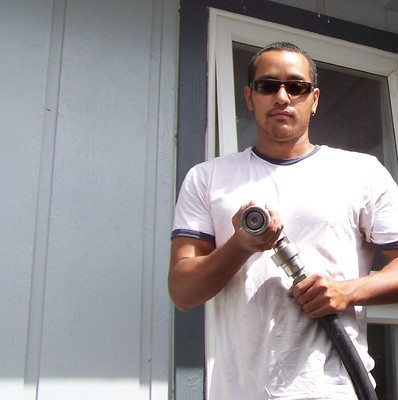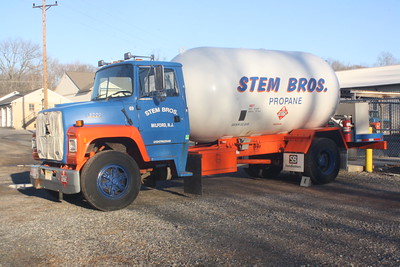
If you have a gas grill, fireplace, or any other type of gas-powered appliance in your home, then you probably use propane. But how can you tell when you need to refill your propane tank? Here are a few things to look for:
Monitor your propane usage: Keep track of how much propane you are using and how frequently you need to refill your tank. If you find that you are running out of propane more often than you would like, it may be time to consider switching to a larger tank or finding a way to use less propane.
Watch for warning signs: Some signs that you may need propane include a drop in the pressure of the gas coming out of your appliances, a decrease in the heat output of your appliances, or a yellow or orange flame instead of a blue flame. If you notice any of these warning signs, it’s important to refill your propane tank as soon as possible to ensure that your appliances continue to function properly.
Set up automatic deliveries: Many propane suppliers offer automatic delivery services, which can help ensure that you never run out of propane. With this service, your supplier will monitor your propane usage and deliver a refill when needed. This can take the guesswork out of determining when to refill your propane tank.
Keep an eye on the tank level
It’s important to keep an eye on your propane tank levels because running out of propane can be dangerous. Here are some tips on how to tell if you need to refill your propane tanks:
- Check the level of your propane tanks regularly. A good rule of thumb is to check the level once a week.
- If you notice that the level of your propane tanks is getting low, don’t wait to refill them. It’s better to refill them sooner rather than later.
- If you run out of propane, you can call a propane company to come and refill your tanks. Delivery can be arranged by the company.
To refill, you’ll need to find a propane supplier. You can usually find propane suppliers at gas stations or hardware stores, if your tanks are small. Once you’ve found a propane supplier, bring your empty propane tank to them and they’ll refill it for you.
What are the signs you need a propane refill
Realizing when you need a propane refill is essential to avoid the inconvenience and potential danger of running out of gas. Here are several signs that suggest it’s time to schedule a propane refill:
1. Gauge Reading
- Most propane tanks have a gauge that shows what percentage of the tank is full. If the gauge indicates that the tank is 20% full or less, it’s time to order a refill.
2. Estimated Time Since Last Fill
- If you haven’t refilled your tank in a while and you have a consistent usage pattern, you can estimate when you’ll need more propane. Generally, if it’s been a few months, it’s wise to check the levels.
3. Drop in Tank Weight
- Propane tanks feel lighter as the gas is used up. If the tank feels unusually light or if a weight check indicates a significant drop, it’s likely time for a refill.
4. Changes in Appliance Performance
- If you notice that your propane appliances are not performing as well as they used to, it might be because your propane supply is running low. For instance, a weak flame on a stove or a decrease in temperature in a propane-powered heater can be indicators.
5. Visible Frost Build-up
- Sometimes, when a propane tank is low on fuel, you might see frost buildup around the tank, especially near the bottom. This can happen because the pressure inside the tank drops as the gas level lowers, causing the remaining propane to cool.
6. Increased Fuel Odor
- Propane is odorized with a chemical to make it smell like rotten eggs or a skunk’s spray. If you’re noticing this smell more frequently near your tank, it could be a sign that the levels are low, causing the odorant to be more concentrated.
7. Run-Time Frequency
- If you’re finding that you need to change or refill portable propane cylinders more frequently than usual, this is a clear indication that your current supply is not meeting your demand.
8. Seasonal Weather Changes
- In colder seasons, propane usage typically increases due to heating demands. If you’re entering winter, it’s prudent to ensure your tank is full.
9. Sudden Inefficiency in Hot Water Supply
- If you use propane to heat your water, a sudden lack of hot water or a significant decrease in water temperature could suggest you’re low on propane.
10. Use of Secondary Heat Sources
- If you find yourself relying more on secondary heat sources, like electric space heaters, it may be because your main propane heat source is low on fuel.
11. Physical Inspection Clues
- Using the physical inspection methods discussed previously, such as the hot water method or checking the tank’s color in sunlight, can also indicate low propane levels.
Safety Note:
- Never ignore the signs of a low propane tank, and always address a suspected leak immediately. If you smell gas or suspect a leak, follow safety protocols, which include extinguishing any open flames, not using electrical switches, vacating the area, and contacting your propane supplier or emergency services from a safe distance.
To ensure consistent propane supply, consider establishing a regular delivery schedule with your provider or investing in a monitoring system that alerts you when it’s time to refill.
Weight-Based Methods (for Cylinders)
Calculating propane levels by tank weight is a reliable method, particularly for smaller cylinders where visual and gauge methods may not be available or accurate. Here’s how you can use weight to determine how much propane you have left:
A. Calculating Propane Levels by Tank Weight
- Find the Tare Weight (TW):
- Every propane tank has a “tare weight” or “T.W.” stamped on its collar. This is the weight of the empty tank and needs to be subtracted from the total weight to determine the weight of the propane.
- Weigh the Tank:
- Use a scale to weigh the tank. If it’s a large tank, it may require a drive-on scale or specialized equipment.
- Calculate Propane Weight:
- Subtract the tare weight from the total current weight of the tank to find the weight of the propane gas remaining.
- Determine Remaining Volume:
- Since propane’s density is about 4.2 pounds per gallon at 60°F, you can divide the weight of the propane by this number to estimate how many gallons you have left.
B. The Relationship Between Weight, Volume, and Fuel Usage
- Propane Density:
- Propane’s density changes with temperature, but a common baseline is that one gallon of propane weighs approximately 4.2 pounds at 60°F.
- Volume Measurement:
- Propane is often sold by volume (gallons or liters), but tanks are filled by weight to account for temperature-induced density changes.
- Fuel Usage:
- Knowing the weight of the propane and its conversion to volume, you can estimate how long the remaining propane will last based on your typical usage rate.
C. Necessary Tools for Weighing a Propane Tank
- Suitable Scale:
- A household scale for small cylinders or a platform scale for larger tanks.
- Industrial scales or weighbridges for very large tanks.
- Temperature Gauge (Optional):
- To adjust your calculations for the current temperature, as propane density changes with temperature.
- Calculator:
- For performing the necessary calculations to determine the weight of the propane.
By using the weight-based method, you can get a precise measurement of how much propane you have left and plan your refill accordingly. Always ensure that the tank is on a stable and level surface when weighing, and handle the tank carefully to avoid injury or damage.
Thermal Methods (for Cylinders)
Thermal methods utilize the principle that propane will absorb heat, causing a temperature difference on the surface of the tank where the propane level is versus where there is no propane.
A. Using Hot Water to Determine Propane Levels
- The Process:
- Pour warm (not boiling) water down the side of the propane tank.
- Run your hand along the side of the tank.
- Feel for a temperature change: the part of the tank that has propane in it will be cooler, while the empty part will be warmer due to the metal absorbing the heat from the water.
- The Explanation:
- The propane inside the tank absorbs the heat from the water, causing the tank to feel cooler at the level where there’s liquid propane and warmer above it where there’s only propane gas.
- Visual Indicator:
- Sometimes, especially on a cooler day, you can see a light condensation line where the propane level is, which corresponds with the temperature difference.
B. Infrared Thermometers as a Tool for Checking Levels
- Using an Infrared Thermometer:
- Point an infrared thermometer along the side of the tank from top to bottom.
- Look for the temperature reading to drop—the point at which the temperature drops is the propane level.
- The Benefits:
- This method provides a contactless way to measure the propane level and is particularly useful for larger tanks.
- It can be quicker and cleaner than using the hot water method.
C. Safety Precautions When Using Thermal Methods
- Water Temperature:
- Ensure that the water is warm and not boiling to prevent burns and avoid any damage to the tank.
- Handling the Infrared Thermometer:
- Follow the manufacturer’s instructions to avoid inaccurate readings.
- Do not point the laser of the thermometer at eyes, either yours or anyone else’s.
- General Precautions:
- Wear protective gloves when handling hot water.
- Ensure the tank is on a stable surface to prevent it from tipping over when touching or pouring water.
- Avoid using these methods near open flames or ignition sources, as propane is highly flammable.
- Post-Check:
- After performing thermal checks, make sure to dry off any water to prevent rust or corrosion on the tank.
These thermal methods offer a quick and effective way to check propane levels without the need for gauges. However, they do require some basic safety precautions to ensure the process is conducted without risk of injury or damage to the tank.
Usage Tracking and Monitoring
Efficiently managing your propane supply involves understanding your usage patterns over time. By tracking and monitoring your consumption, you can predict future needs more accurately and schedule refills accordingly.
A. Keeping a Usage Log to Track Propane Consumption Over Time
- Manual Logging:
- Create a simple log where you record the date, the level of propane (if you have a gauge), the weather conditions (as colder weather typically means more propane usage), and any significant changes in your usage patterns (e.g., guests staying over, new appliances).
- Consistent Measurement:
- Make regular checks, for example, every Sunday morning, to track your usage over a consistent period, which helps in establishing a pattern.
- Tracking Fuel Purchases:
- Log every propane purchase with the date and amount of propane bought to keep a running total of your usage.
B. Using Historical Data to Predict Future Needs
- Analyzing Consumption Patterns:
- Look for trends in your usage log to see when your consumption increases or decreases, and relate it to the time of year, lifestyle changes, or weather conditions.
- Estimating Future Use:
- Use your historical data to estimate your propane needs for the upcoming seasons, adjusting for any expected changes in living conditions or habits.
- Planning Refills:
- Based on past usage, you can schedule future deliveries before reaching critical low levels, thus avoiding the risks of running out.
C. Digital and Smart Monitors for Continuous Tracking
- Smart Propane Gauges:
- Invest in a smart propane gauge that connects to your tank and sends real-time data to your smartphone or computer.
- Integration with Home Automation:
- Some smart monitors can be integrated with home automation systems, allowing for more detailed tracking and management of propane usage.
- Alerts and Notifications:
- Set up notifications for when your propane levels reach a certain percentage, so you can order a refill without having to manually check the tank.
- Data Analysis:
- Use the app or software provided with the digital monitor to analyze your usage patterns. These platforms often provide insights into your average consumption and predict when you’ll need a refill.
- Supplier Integration:
- Some suppliers can integrate with these monitoring systems to automatically schedule a delivery when your tank reaches a pre-set level.
Using a combination of these methods can streamline the process of propane management. While a usage log provides a personal touch and helps with understanding specific household patterns, digital and smart monitors offer convenience, accuracy, and peace of mind through automated tracking and alerts. By leveraging these tools, you can ensure that your propane supply is well-managed and that your refills are timely, based on accurate and personalized usage data.
Understanding Propane Delivery Schedules
Properly understanding your propane delivery options will help you avoid unexpected runouts, especially during peak usage times. Here’s a breakdown of the delivery types and how to manage them effectively.
A. Types of Delivery Options: Will-Call vs. Automatic Delivery
- Will-Call:
- The homeowner monitors their propane levels and calls the supplier to request a delivery when needed.
- This option is more hands-on and requires you to keep a close eye on your tank’s levels.
- Automatic Delivery:
- The supplier estimates your usage based on past consumption and weather patterns, then schedules deliveries automatically before your tank runs low.
- This service is typically under a contract with a predetermined schedule of deliveries.
B. Pros and Cons of Different Delivery Schedules
- Pros:
- Control over when you get propane and how much is delivered.
- You can shop around for the best price if you’re not under contract.
- More flexibility in managing your propane usage and expenses.
- Cons:
- Risk of running out if you don’t monitor levels closely.
- Prices can fluctuate, so you might pay more if you need propane when prices are high.
- Delivery may not be as prompt, depending on demand and supplier availability.
- Pros:
- Less worry about running out of propane since the supplier manages delivery.
- Payments and delivery can often be spread out to even monthly billing.
- Suppliers may offer guaranteed pricing or discounts for automatic delivery customers.
- Cons:
- Less control over timing and quantity of deliveries.
- You may receive more propane than needed if your usage decreases.
- It may be harder to take advantage of price drops since you’re not actively monitoring.
C. How to Communicate with Your Supplier About Your Needs
- Understand Your Contract:
- If you opt for automatic delivery, understand the terms of your agreement. Know your rights and responsibilities, such as minimum usage requirements or fees for breaking a contract.
- Communicate Changes in Usage:
- If you’re on an automatic delivery schedule and your propane usage changes significantly (e.g., due to adding a room, installing a new appliance, or a change in occupancy), inform your supplier so they can adjust your delivery schedule accordingly.
- Monitor and Share Usage Data:
- Even if you’re on automatic delivery, keep an eye on your tank levels and consumption patterns. If they don’t match the supplier’s delivery schedule, share this data with them.
- Ask About Pricing Plans:
- Suppliers often have different pricing plans that can provide savings based on pre-purchase, fixed pricing, or capped rates. Discuss these options to see what works best for your budget and usage.
- Emergency Refills:
- Know the procedure for emergency deliveries. If you’re a will-call customer and you run out, or if there’s a sudden cold snap, you need to know how quickly your supplier can respond.
- Feedback and Reviews:
- Provide feedback about service and delivery experiences. Suppliers often adjust their services based on customer satisfaction reviews and feedback.
Good communication and a clear understanding of your propane needs and delivery options will help ensure that you maintain a consistent supply of propane for your home or business. Whether you choose will-call or automatic delivery, staying informed and engaged with your supplier is key to managing your propane supply effectively.
To make a conclusion
In summary, effectively managing your propane supply comes down to a keen awareness of how to measure your tank’s levels, diligently tracking your usage, and selecting a delivery schedule that aligns with your unique needs.
- Utilize visual, weight-based, and thermal methods to keep an accurate read on your propane levels. Whether you choose one or combine them, these techniques can help you stay on top of your propane requirements.
- Keeping a log or using smart monitors is crucial for anticipating your future propane consumption. This foresight is key to ensuring you never run out when you need it most.
- Deciding on will-call or automatic delivery should reflect your balance between personal control and convenience. Weigh the advantages and disadvantages of each to determine which harmonizes best with your lifestyle, and budget, and how involved you want to be in managing your supply.
- Effective communication with your propane supplier is crucial, especially if your consumption changes or you have specific preferences for delivery. Staying proactive and well-informed can help avoid surprises and may even lead to cost savings.
Remember, when dealing with propane, safety comes first. It’s always better to overestimate your needs than to find yourself short. By being vigilant with your propane monitoring, maintaining clear records, understanding your delivery choices, and keeping an open dialogue with your provider, you’ll be well-equipped to handle your propane needs smoothly and safely, no matter the season. Your comfort and peace of mind are paramount, and a well-managed propane supply is a solid step toward that goal.

Mike is an experienced propane technician with over 15 years of professional experience in the field. He has dedicated his career to helping customers with their propane needs, from installation to maintenance and repair. Together with Jeremy, he co-founded this website to provide useful information and guidance to customers seeking reliable propane services.



